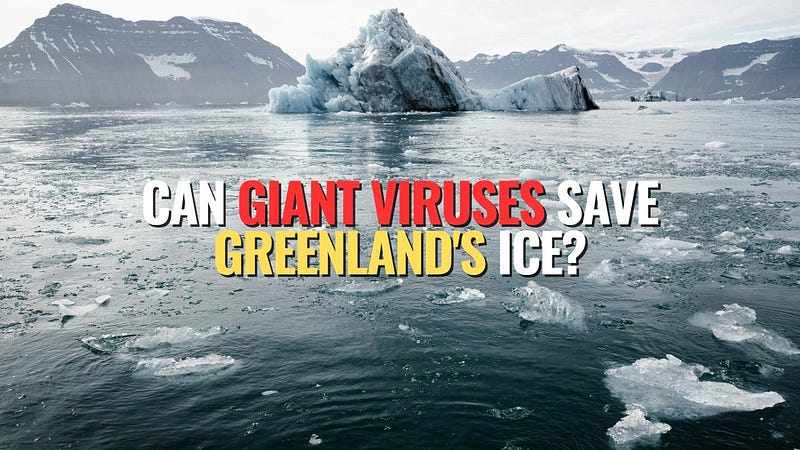Can Giant Viruses Help Preserve Greenland's Glaciers?
Written on
The Melting Ice of Greenland
For years, researchers have been sounding the alarm about the rapid melting of Greenland's glaciers, a trend closely linked to rising global temperatures. This melting process is further accelerated by algae, which have recently been found to be infected by giant viruses.

Greenland is the world's largest island, nestled in the Atlantic Ocean, and is increasingly attracting tourists who marvel at its untouched natural beauty. However, the island's environment is undergoing significant transformations.
The Accelerating Ice Loss
In recent times, scientists have noted a concerning increase in the rate at which Greenland's ice sheets are melting. It's crucial to recognize that the ice sheets of both Antarctica and Greenland hold over 99% of the Earth’s freshwater ice. The potential disappearance of these ice masses could result in a staggering sea level rise of more than 67 meters. Currently, ice covers roughly 80% of Greenland.
This accelerated melting is primarily driven by global warming, with algae blooms that occur during springtime contributing to the darkening of extensive ice areas. This darkening reduces the ice's ability to reflect sunlight, leading to an even faster melting process.
The Role of Giant Viruses
Led by Dr. Laura Perini from Aarhus University’s Department of Environmental Sciences, a team of scientists collected samples from Greenland's glaciers. Photos from this investigation show dark brown water contained in a plastic bag, which was later analyzed in the lab.
“In both the dark ice and the reddish snow—indicative of a specific algae species—we detected signatures of active giant viruses. This marks the first time they have been identified on the surfaces of ice and snow rich in pigmented microalgae,” Dr. Perini explains.
Giant viruses were first discovered in the ocean in 1981, where they infected algae. Subsequent research revealed their presence in terrestrial soils and even within humans. While typical viruses measure between 20–200 nanometers, giant viruses can be as large as 2.5 micrometers, making them larger than most bacteria. Furthermore, their genomes are significantly more complex than those of standard viruses.
Contrary to the long-held belief that glaciers were devoid of life, new findings suggest that they host not just algae, but also bacteria, filamentous fungi, and even giant viruses.

Unseen Giants
Despite their size, these newly identified viruses are not visible to the naked eye, and Dr. Perini has yet to observe them under a microscope. So, how did she confirm their presence?
“Our discovery stemmed from analyzing the DNA present in the samples we collected. By scrutinizing this extensive dataset for specific marker genes, we identified sequences closely resembling known giant viruses,” the researcher elaborates.
To ensure that the viral DNA originated from active microorganisms rather than long-extinct ones, the entire mRNA from the sample was extracted for further validation.
Potential Applications of Giant Viruses
Giant viruses remain largely enigmatic, with much still to learn about them. Unlike most viruses, they possess numerous active genes that allow them to repair, replicate, transcribe, and translate DNA. The mechanisms behind these processes are not yet fully understood.
Researchers aim to identify the organisms infected by these viruses. Some are likely to target algae, while others may infect protists, which are eukaryotic organisms, including single-celled fungi-like life forms.
Scientists are hopeful that by studying these viruses, they may discover methods to regulate the growth of snow algae, potentially curbing glacier melting in the future. The viruses likely consume snow algae, possibly serving as a natural mechanism to manage algal blooms.
What Lies Beneath: The Beast of Gévaudan
Gévaudan is a historic region in France, renowned for its legends and lore surrounding mysterious creatures...
Attention to Readers!
As a content creator on Medium.com, I face challenges in receiving fair compensation for my efforts. If you find my articles valuable, please consider supporting me on my “Buy Me a Coffee” page. Your contributions can greatly assist in fueling my passion for producing quality content. Thank you for your generous support!

